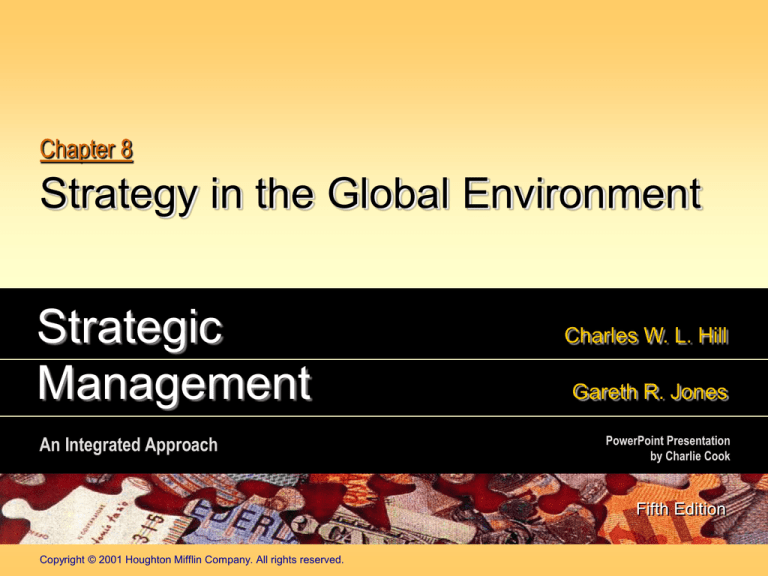
Chapter 8
Strategy in the Global Environment
Strategic
Management
An Integrated Approach
Charles W. L. Hill
Gareth R. Jones
PowerPoint Presentation
by Charlie Cook
Fifth Edition
Copyright © 2001 Houghton Mifflin Company. All rights reserved.
Profiting From Global Expansion
Earning high returns from transferring distinctive
competencies to foreign markets.
Realizing location economies
Using lower-cost locations reduces overall costs and fosters
product differentiation for premium pricing.
Moving down the experience curve
Larger global markets = more accumulated volume.
Global expansion and business-level strategies
Linked by cost reductions and value creation.
Copyright © 2001 Houghton Mifflin Company. All rights reserved.
8-2
Pressures for Cost Reduction and Local
Responsiveness
Pressures for cost reductions
Global competitors seek to minimize unit costs through
location economies and attain low-cost competitor status.
In commodity-type product industries, intense price
competition predominates strategic concerns.
Pressures for local responsiveness arise from:
Differences in local consumer tastes and preferences.
Differences in infrastructure and traditional practices.
Differences in distribution channels among countries.
Host government economic and political demands.
Copyright © 2001 Houghton Mifflin Company. All rights reserved.
8-3
Pressures for Cost Reduction and Local
Responsiveness
FIGURE 8.1
Copyright © 2001 Houghton Mifflin Company. All rights reserved.
8-4
Strategic Choice
International strategy
Create value by transferring skills
and products abroad.
Multidomestic strategy
Maximize local responsiveness by
customizing products and marketing
strategy for local markets.
Global strategy
Pursue low-cost status, offer standardized global products.
Transnational strategy
Use global learning to achieve low-cost status, differentiation,
and local responsiveness simultaneously.
Copyright © 2001 Houghton Mifflin Company. All rights reserved.
8-5
Four Basic Strategies
FIGURE 8.2
Copyright © 2001 Houghton Mifflin Company. All rights reserved.
8-6
Cost Pressures and Pressures for Local
Responsiveness Facing Caterpillar
FIGURE 8.3
Copyright © 2001 Houghton Mifflin Company. All rights reserved.
8-7
The Advantages and Disadvantages of Different
Strategies for Competing Globally
Strategy
Advantages
Disadvantages
International
• Transfer of distinctive competencies
to foreign markets
• Lack of local responsiveness
• Inability to realize location economies
• Failure to exploit experience-curve
effects
Multidomestic
• Ability to customize product offerings
and marketing in accordance with
local responsiveness
• Inability to realize location economies
• Failure to exploit experience-curve
effects
• Failure to transfer distinctive
competencies to foreign markets
Global
• Ability to exploit experience-curve
effects
• Ability to exploit location economies
• Lack of local responsiveness
Transnational
• Ability to exploit experience-curve
effects
• Ability to exploit location economies
• Ability to customize product offerings
and marketing in accordance with
local responsiveness
• Reaping benefits of global learning
• Difficulties in implementation because
of organizational problems
TABLE 8.1
Copyright © 2001 Houghton Mifflin Company. All rights reserved.
8-8
Basic Entry Decisions
Which foreign markets?
Politically and financially stable
Developed and developing nations
Free market systems
Timing of entry
Pioneering costs versus
first-mover advantages.
Scale of entry and strategic commitments
Scale of entry affects the nature of competition in the national
market. Implications of risks and benefits must be weighed
carefully.
Copyright © 2001 Houghton Mifflin Company. All rights reserved.
8-9
The Choice of Entry Mode
Exporting
Licensing
Franchising
Joint Ventures
Wholly Owned Subsidiaries
Distinctive Competencies and Entry Mode
Pressures for Cost Reduction and Entry Mode
Copyright © 2001 Houghton Mifflin Company. All rights reserved.
8-10
The Advantages and Disadvantages of Different Entry
Modes
Entry Mode
Advantages
Disadvantages
Exporting
• Ability to realize location and
experience-curve economies
• High transport costs
• Trade barriers
• Problems with local marketing agents
Licensing
• Low development costs and risks
• Inability to realize location and
experience-curve economies
• Inability to engage in global strategic
coordination
• Lack of control over technology
Franchising
• Low development costs and risks
• Inability to engage in global strategic
coordination
• Lack of control over quality
Joint
ventures
• Access to local partner’s knowledge
• Shared development costs and risks
• Political dependency
• Inability to engage in global strategic
coordination
• Inability to realize location and
experience-curve economies
• Lack of control over technology
Wholly owned
subsidiaries
• Protection of technology
• Ability to engage in global strategic
coordination
• Ability to realize location and
experience-curve economies
• High costs and risks
TABLE 8.2
Copyright © 2001 Houghton Mifflin Company. All rights reserved.
8-11
Global Strategic Alliances
Advantages
Facilitate entry into foreign
markets.
Enable partners to share
fixed costs and risks
associated with new
products and processes.
Facilitate transfer of
complementary skills
between companies.
Help establish
technological standards.
Copyright © 2001 Houghton Mifflin Company. All rights reserved.
Disadvantages
Risk of giving away
technological know-how.
Risk of opening local
market access to foreign
alliance partner.
Risk of not getting
anything in return.
8-12
Making Strategic Alliances Work
Partner selection when done well:
Helps the firm achieve
its strategic goals.
Results in a commonly
shared vision for the alliance.
Reduces opportunistic
behaviors by the partners.
Copyright © 2001 Houghton Mifflin Company. All rights reserved.
8-13
Structuring Alliances to Reduce
Opportunism
“Walling off”
FIGURE 8.4
Copyright © 2001 Houghton Mifflin Company. All rights reserved.
8-14
Managing the Alliance
Maximizing the benefits of an alliance:
Develop a sensitivity to cultural differences.
Build interpersonal relationships and networks among
managers from different companies.
Learn from alliance
partners and put the
knowledge to use in
the organization.
Copyright © 2001 Houghton Mifflin Company. All rights reserved.
8-15

